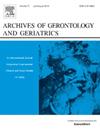Global trends and burden of age-related hearing loss: 32-year study
IF 3.5
3区 医学
Q2 GERIATRICS & GERONTOLOGY
引用次数: 0
Abstract
Background
Age-related hearing loss (ARHL) is a major cause of disability and diminished quality of life in older adults. This study uses data from the 2021 Global Burden of Disease (GBD) study to assess global ARHL.
Methods
We evaluated ARHL prevalence, DALYs (Disability-Adjusted Life Years), ASPR (Age-Standardized Prevalence Rate), and ASDR (Age-Standardized DALYs Rate). Trend analysis was conducted using Estimated Annual Percentage Change (EAPC), with projections to 2050.
Result
From 1990 and 2021, global ARHL prevalence cases and DALYs increased by 109 %, reaching 1.55 billion and 44.45 million, respectively. The ASPR increased from 17,106.88 to 18,070.26, while the crude prevalence rate significantly from 13,890.66 to 19,587.14. Both ASPR and ASDR demonstrated significant age-related increases, particularly for moderate and moderately severe ARHL, with EAPC values of 1.39 and 1.49 for ASDR, respectively. Among individuals aged over 85 years, the ASPR of ARHL is expected to reach 80 %. Prevalence cases peaked in the 55–69 age group, with the highest number of cases (179.43 million) observed in the 55–59 subgroup. High-middle SDI regions and East Asia exhibited the most rapid growth. By 2050, ARHL cases are projected to reach 2.31 billion, with ASPR and ASDR expected to continue rising.
Conclusion
ARHL has increased globally over the past three decades, largely due to population aging. The burden is most severe in middle SDI regions, East Asia, and the 55–69 age group, primarily due to their substantial population bases. Addressing this escalating challenge requires enhanced public awareness, early screening initiatives, and targeted interventions.
年龄相关性听力损失的全球趋势和负担:32年研究
背景:年龄相关性听力损失(ARHL)是老年人残疾和生活质量下降的主要原因。本研究使用2021年全球疾病负担(GBD)研究的数据来评估全球ARHL。方法评估ARHL患病率、残疾调整生命年(DALYs)、年龄标准化患病率(ASPR)和年龄标准化DALYs率(ASDR)。趋势分析使用估计年度百分比变化(EAPC)进行,预测到2050年。结果从1990年到2021年,全球ARHL患病率和DALYs分别增长了109%,达到15.5亿例和4445万例。ASPR从17106.88增加到18070.26,粗患病率从13890.66增加到19587.14。ASPR和ASDR均表现出明显的年龄相关增加,特别是中度和中度重度ARHL, ASDR的EAPC值分别为1.39和1.49。在85岁以上的人群中,ARHL的ASPR有望达到80%。流行病例在55-69岁年龄组达到高峰,在55-59岁亚组中观察到的病例数最多(1.7943亿)。中高SDI地区和东亚地区增长最快。到2050年,ARHL病例预计将达到23.1亿例,ASPR和ASDR预计将继续上升。结论近30年来,arhl在全球范围内呈上升趋势,主要原因是人口老龄化。这种负担在SDI中部地区、东亚和55-69岁年龄组最为严重,这主要是由于这些地区的人口基数很大。应对这一不断升级的挑战需要提高公众意识,开展早期筛查行动,并采取有针对性的干预措施。
本文章由计算机程序翻译,如有差异,请以英文原文为准。
求助全文
约1分钟内获得全文
求助全文
来源期刊
CiteScore
7.30
自引率
5.00%
发文量
198
审稿时长
16 days
期刊介绍:
Archives of Gerontology and Geriatrics provides a medium for the publication of papers from the fields of experimental gerontology and clinical and social geriatrics. The principal aim of the journal is to facilitate the exchange of information between specialists in these three fields of gerontological research. Experimental papers dealing with the basic mechanisms of aging at molecular, cellular, tissue or organ levels will be published.
Clinical papers will be accepted if they provide sufficiently new information or are of fundamental importance for the knowledge of human aging. Purely descriptive clinical papers will be accepted only if the results permit further interpretation. Papers dealing with anti-aging pharmacological preparations in humans are welcome. Papers on the social aspects of geriatrics will be accepted if they are of general interest regarding the epidemiology of aging and the efficiency and working methods of the social organizations for the health care of the elderly.

 求助内容:
求助内容: 应助结果提醒方式:
应助结果提醒方式:


